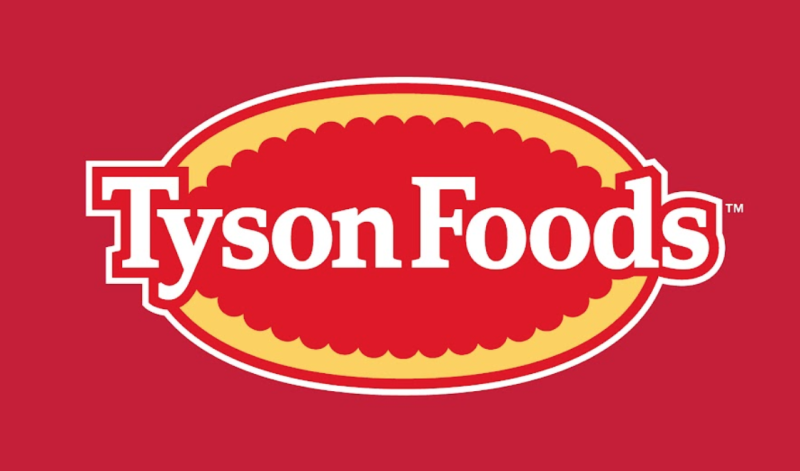In today’s edition of the Daily Stock Report, we are going to explore Tyson Foods (TSN). This is the first time we have highlighted TSN in our daily commentary. Tyson Foods fell to the yellow zone with a Red SMAX in the SIA S&P 500 Index Report back on August 2, 2022, at a price of $87.51. As we see in the relative strength matrix position chart, Tyson Foods has further fallen to the red unfavored zone and still resides there today. The shares did rally back to the yellow zone recently but did not re-enter our green favored zone, succumbing to relative strength pressure and falling right back into the red zone. As of Friday’s close, the shares are at $55.30 which represents a 37% drop since August 2, 2022.
This is another great example on the value of staying away from investments in the red unfavored zone. Many advisors may instinctively look for names in the unfavored zone with the mentality that the shares are oversold and a “value buy” is in play. However, “value buys” may in fact be “value traps” and the shares may continue to fall further in price which is, in fact, what has occurred here. This reinforces SIA’s methodology not to pursue a “contrarian” mindset as names in the unfavored zone are not exhibiting any relative strength as the sellers are in control and not many market participants are looking at the name. The SIA Charts relative strength rankings help advisors identify stocks that are not just outperforming peers or index benchmarks, but in this case also underperforming peers or index benchmarks with such underperformance often signaling deteriorating investor expectations for company or sector growth. Currently, TSN resides in the #372 spot out of 505 positions in the SIA S&P 500 Index report.
Let’s dive in and see what the candlestick chart looks like to consider what may lie ahead for Tyson Foods. In early 2022, we see the investment bumped its head at the $90 level twice in February and April of 2022. Then a precipitous drop of price materialized with a strong and steady downtrend in place before the shares finally found a bottom at the $42 area back in October of 2023. A rally had then emerged up until September of last year, when the rally ran out of steam at the $65 level which is now followed by another pullback and potential consolidation pattern. The Company reported their latest quarterly earnings last week which the market did not take too kindly to, and we see the last candlestick form rather bearish – as the closing price of the candle is lower than the opening price of the candlestick. It will be interesting to see if the selling pressure will subside once the latest quarterly earnings news gets “baked in” to the price. Currently, we can see support at the $53.00 area which is at the lower end of this trading range while resistance is clustered at the top of this range at approximately $65 - $66 area.
In looking at the Point and Figure chart we also see the investment hit its head at the $90.98 level twice in 2022, and the sharp fall in the shares materializing up until November of 2023. Coincidentally, the rally that ensued stalled at the long-term downtrend line (red line) at $64.98 in September of last year. This is the power of Point and Figure Charting, wherein long-term trend lines (both downtrend lines and uptrend lines) can act as resistance and support levels which you can’t see in a line or candlestick chart; helping you identify where a rally can potentially stall, as in this case. On the flip side, we see the shares approaching their long-term uptrend line at $54.37 so this will be an area to watch to see if the shares can find support at its long-term uptrend line (green line). If the shares fail to hold here, next possible support is at $48.28 to $49.24 area. To the upside, resistance is at its 3-box reversal of $60.03 and, above that, $64.98. With a SMAX score of 2 out of 10, TSN is not exhibiting much near-term strength against the asset classes.
Tyson Foods is the largest U.S. producer of processed chicken and beef. It's also a large producer of processed pork and protein-based products under the brands Jimmy Dean, Hillshire Farm, Ball Park, Sara Lee, Aidells, State Fair, and Raised & Rooted, to name a few. Tyson sells 81% of its products through various U.S. channels, including retailers (47% in fiscal 2021), food service (32%), and other packaged food and industrial companies (10%). In addition, 11% of the company's revenue comes from exports to Canada, Mexico, Brazil, Europe, China, and Japan.
Disclaimer: SIACharts Inc. specifically represents that it does not give investment advice or advocate the purchase or sale of any security or investment whatsoever. This information has been prepared without regard to any particular investors investment objectives, financial situation, and needs. None of the information contained in this document constitutes an offer to sell or the solicitation of an offer to buy any security or other investment or an offer to provide investment services of any kind. As such, advisors and their clients should not act on any recommendation (express or implied) or information in this report without obtaining specific advice in relation to their accounts and should not rely on information herein as the primary basis for their investment decisions. Information contained herein is based on data obtained from recognized statistical services, issuer reports or communications, or other sources, believed to be reliable. SIACharts Inc. nor its third party content providers make any representations or warranties or take any responsibility as to the accuracy or completeness of any recommendation or information contained herein and shall not be liable for any errors, inaccuracies or delays in content, or for any actions taken in reliance thereon. Any statements nonfactual in nature constitute only current opinions, which are subject to change without notice.















